Exploration of Cytotoxic Potential of Longifolene/Junipene Isolated from Chrysopogon zizanioides
Abstract
:1. Introduction
2. Results and Discussion
2.1. Percent Extractive Yield Value
2.2. Isolation of a Compound from Chrysopogon zizanioides
2.3. Structural Characterization of Isolated Unknown Compound ‘X’
2.3.1. HPLC Analysis of Isolated Unknown Compound ‘X’
2.3.2. FTIR of Isolated Unknown Compound ‘X’
2.3.3. NMR of Isolated Unknown Compound ‘X’
Proton NMR
Carbon 13 13C NMR
2.3.4. LC-MS of Isolated Unknown Compound ‘X’
- Name of compound: longifolene/junipene
- Molecular formula: C15H24
- Molecular weight: 204.6
- Its structure is mentioned in Figure 2.
2.3.5. Cytotoxicity Profile of Isolated Junipene/Longifolene and Doxorubicin
3. Experimental Section
3.1. Materials
3.2. Plant Roots and Their Extraction
3.3. Isolation of a Pure Compound
Separation of Bands and Their Fractions
Isolation of Unknown Compound X
3.4. Structural Characterization
3.4.1. HPLC Analysis
3.4.2. Infra-Red (IR) Spectroscopy
3.4.3. Nuclear Magnetic Resonance (NMR)
3.4.4. Mass Spectrometry (MS)
3.5. Cytotoxic Studies
3.5.1. Cancer Cell Lines
3.5.2. MTT (3-(4,5-Dimethylthiazol-2-yl)-2,5-Diphenyltetrazolium Bromide) Assay
4. Conclusions
Supplementary Materials
Author Contributions
Funding
Institutional Review Board Statement
Informed Consent Statement
Data Availability Statement
Conflicts of Interest
References
- Chauthe, S.K.; Mahajan, S.; Rachamalla, M.; Tikoo, K.; Singh, I.P. Synthesis and evaluation of linear furanocoumarins as potential anti-breast and anti-prostate cancer agents. Med. Chem. Res. 2015, 24, 2476–2484. [Google Scholar] [CrossRef]
- Kumar, V.; Rachamalla, M.; Nandekar, P.; Khatik, G.L.; Sangamwar, A.T.; Tikoo, K.; Nair, V.A. Design and synthesis of optically pure 3-aryl-6-methyl-2-thioxotetrahydropyrimidin-4 (1 H)-ones as anti-prostate cancer agents. RSC Adv. 2014, 4, 37868–37877. [Google Scholar] [CrossRef]
- Wang, H.; Naghavi, M.; Allen, C.; Barber, R.M.; Bhutta, Z.A.; Carter, A.; Casey, D.C.; Charlson, F.J.; Chen, A.Z.; Bell, M.L.; et al. Global, regional, and national life expectancy, all-cause mortality, and cause-specific mortality for 249 causes of death, 1980–2015: A systematic analysis for the Global Burden of Disease Study 2015. Lancet 2016, 388, 1459–1544. [Google Scholar] [CrossRef]
- Sung, H.; Ferlay, J.; Siegel, R.L.; Laversanne, M.; Soerjomataram, I.; Jemal, A.; Bray, F. Global cancer statistics 2020: GLOBOCAN estimates of incidence and mortality worldwide for 36 cancers in 185 countries. CA Cancer J. Clin. 2021, 71, 209–249. [Google Scholar] [CrossRef] [PubMed]
- Cassileth, B.R.; Deng, G. Complementary and alternative therapies for cancer. Oncologist 2004, 9, 80–89. [Google Scholar] [CrossRef]
- Yadav, R.; Das, J.; Lalhlenmawia, H.; Tonk, R.K.; Singh, L.; Kumar, D. Targeting cancer using phytoconstituents-based drug delivery. In Advanced Drug Delivery Systems in the Management of Cancer; Academic Press: Cambridge, MA, USA, 2021; pp. 499–508. [Google Scholar]
- Akkol, E.K.; Tatlı, I.I.; Karatoprak, G.Ş.; Ağar, O.T.; Yücel, Ç.; Sobarzo-Sánchez, E.; Capasso, R. Is emodin with anticancer effects completely innocent? Two sides of the coin. Cancers 2021, 13, 2733. [Google Scholar] [CrossRef]
- Pagano, E.; Venneri, T.; Lucariello, G.; Cicia, D.; Brancaleone, V.; Nanì, M.; Cacciola, N.; Capasso, R.; Izzo, A.; Borrelli, F.; et al. Palmitoylethanolamide reduces colon cancer cell proliferation and migration, influences tumor cell cycle and exerts in vivo chemopreventive effects. Cancers 2021, 13, 1923. [Google Scholar] [CrossRef]
- Ahmed, S.; Khan, H.; Aschner, M.; Mirzae, H.; Akkol, E.K.; Capasso, R. Anticancer potential of furanocoumarins: Mechanistic and therapeutic aspects. Int. J. Mol. Sci. 2020, 21, 5622. [Google Scholar] [CrossRef]
- Akkol, E.K.; Genç, Y.; Karpuz, B.; Sobarzo-Sánchez, E.; Capasso, R. Coumarins and coumarin-related compounds in pharmacotherapy of cancer. Cancers 2020, 12, 1959. [Google Scholar] [CrossRef]
- Silva, J.D.N.; Monção, N.B.N.; de Farias, R.R.S.; Citó, A.M.D.G.L.; Chaves, M.H.; de Araújo, M.R.S.; Lima, D.J.B.; Pessoa, C.; de Lima, A.; Araújo, E.C.D.C.; et al. Toxicological, chemopreventive, and cytotoxic potentialities of rare vegetal species and supporting findings for the Brazilian Unified Health System (SUS). J. Toxicol. Environ. Health Part A 2020, 83, 525–545. [Google Scholar] [CrossRef]
- Madhuri, S.; Pandey, G. Some anticancer medicinal plants of foreign origin. Curr. Sci. 2009, 96, 779–783. [Google Scholar]
- Vetiveria Zizanioides (L.) Nash (1999)|www.Narcis.NL. Available online: https://www.narcis.nl/publication/RecordID/oai%3Alibrary.wur.nl%3Awurpubs%2F60974 (accessed on 5 March 2022).
- Duke, J.A. CRC handbook of medicinal herbs. Int. Clin. Psychopharmacol. 1990, 5, 74. [Google Scholar] [CrossRef]
- Vetiver Grass—The Plant—The Vetiver Network International. Available online: https://www.vetiver.org/vetiver-grass-technology/the-plant/ (accessed on 28 July 2022).
- Ushira, Vetiver (Vetiveria Zizanioides)—Practical Uses, Benefits and Dosage. Available online: https://www.planetayurveda.com/library/ushira-vetiveria-zizanioides/ (accessed on 28 July 2022).
- Grover, M.; Behl, T.; Virmani, T.; Bhatia, S.; Al-Harrasi, A.; Aleya, L. Chrysopogon zizanioides—A review on its pharmacognosy, chemical composition and pharmacological activities. Environ. Sci. Pollut. Res. 2021, 28, 44667–44692. [Google Scholar] [CrossRef]
- Grover, M.; Behl, T.; Virmani, T. Phytochemical screening, antioxidant assay and cytotoxic profile for different extracts of Chrysopogon zizanioides roots. Chem. Biodivers. 2021, 18, e2100012. [Google Scholar] [CrossRef] [PubMed]
- Joseph-Nathan, P.; Santillan, R.L.; Schmitt, P.; Günther, H. The study of longifolene by two-dimensional NMR spectroscopy. Org. Magn. Reson. 1984, 22, 450–453. [Google Scholar] [CrossRef]
- Api, A.; Belsito, D.; Biserta, S.; Botelho, D.; Bruze, M.; Burton, G.; Buschmann, J.; Cancellieri, M.; Dagli, M.; Date, M.; et al. RIFM fragrance ingredient safety assessment, longifolene, CAS Registry Number 475-20-7. Food Chem. Toxicol. 2019, 134, 110823. [Google Scholar] [CrossRef]
- Zhu, X.P.; Lin, G.S.; Duan, W.G.; Li, Q.M.; Li, F.Y.; Lu, S.Z. Synthesis and antiproliferative evaluation of novel longifolene-derived tetralone derivatives bearing 1, 2, 4-triazole moiety. Molecules 2020, 25, 986. [Google Scholar] [CrossRef]
- Li, Q.M.; Lin, G.S.; Duan, W.G.; Cui, Y.C.; Li, F.Y.; Lei, F.H.; Li, D.P. Design, synthesis, and antiproliferative evaluation of novel longifolene-derived tetraline pyrimidine derivatives with fluorescence properties. New J. Chem. 2022, 46, 8688–8697. [Google Scholar] [CrossRef]
- Koo, H.N.; Hong, S.H.; Song, B.K.; Kim, C.H.; Yoo, Y.H.; Kim, H.M. Taraxacum officinale induces cytotoxicity through TNF-α and IL-1α secretion in Hep G2 cells. Life Sci. 2004, 74, 1149–1157. [Google Scholar] [CrossRef]
- Kim, Y.S.; Kim, J.S.; Park, S.-H.; Choi, S.-U.; Lee, C.O.; Kim, S.-K.; Kim, S.H.; Ryu, S.Y. Two cytotoxic sesquiterpene lactones from the leaves of Xanthium strumarium and their in vitro inhibitory activity on farnesyltransferase. Planta Med. 2003, 69, 375–377. [Google Scholar] [CrossRef]
- Sturgeon, C.M.; Craig, K.; Brown, C.; Rundle, N.T.; Andersen, R.J.; Roberge, M. Modulation of the G2 cell cycle checkpoint by sesquiterpene lactones psilostachyins A and C isolated from the common ragweed Ambrosia artemisiifolia. Planta Med. 2005, 71, 938–943. [Google Scholar] [CrossRef] [PubMed]
- Wang, M.; Gu, D.; Li, H.; Wang, Q.; Kang, J.; Chu, T.; Guo, H.; Yang, Y.; Tian, J. Rapid prediction and identification of lipase inhibitors in volatile oil from Pinus massoniana L. needles. Phytochemistry 2017, 141, 114–120. [Google Scholar] [CrossRef] [PubMed]
- Grover, M.; Behl, T.; Sehgal, A.; Singh, S.; Sharma, N.; Virmani, T.; Rachamalla, M.; Farasani, A.; Chigurupati, S.; Alsubayiel, A.M.; et al. In vitro phytochemical screening, cytotoxicity studies of curcuma longa extracts with isolation and characterisation of their isolated compounds. Molecules 2021, 26, 7509. [Google Scholar] [CrossRef] [PubMed]
- Poornima, B.; Prasad, K.V.S.R.G.; Bharathi, K. Evaluation of solid-state forms of curcuminoids. Int. J. Pharm. Sci. Res. 2016, 7, 4035–4044. [Google Scholar]
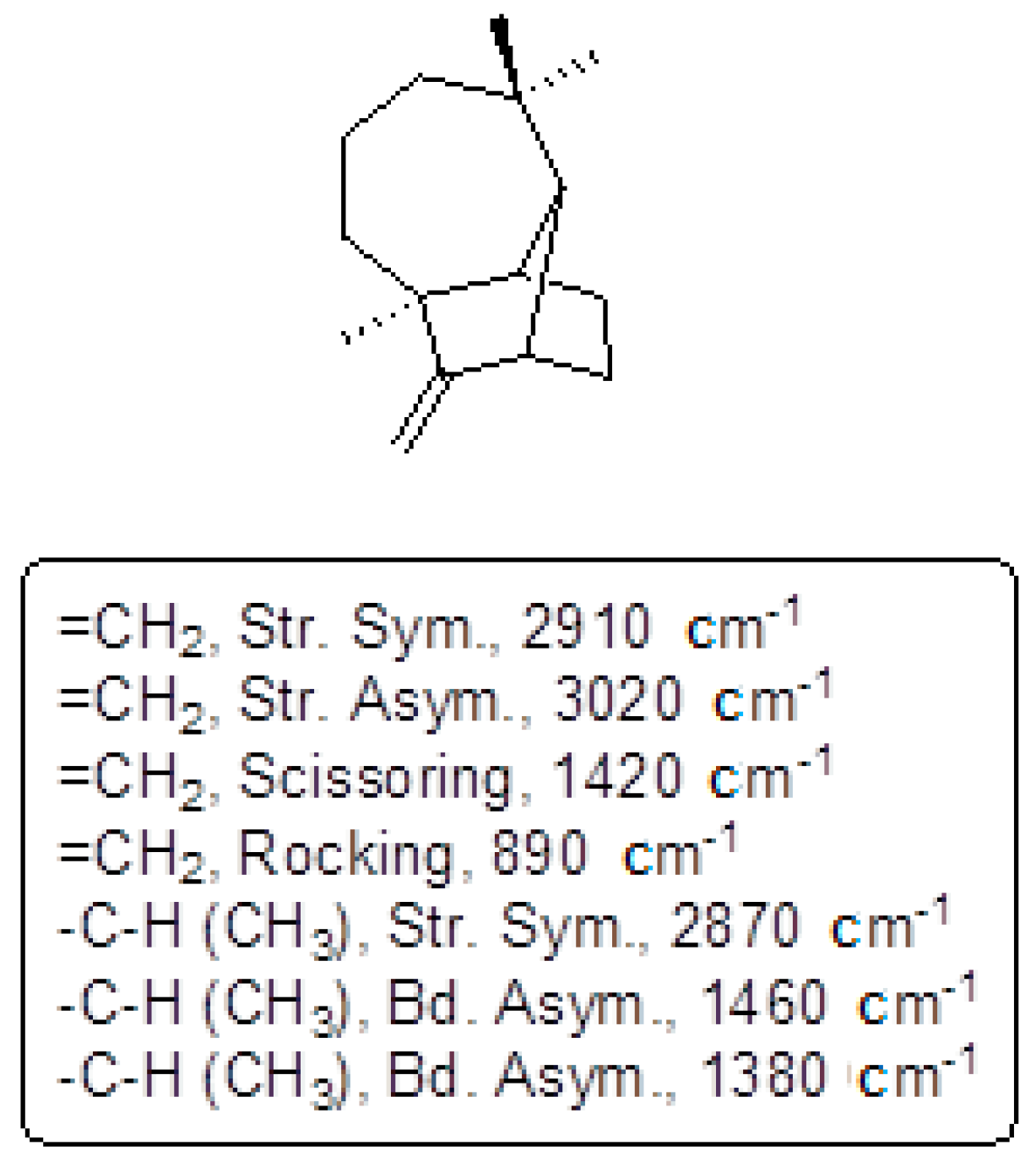
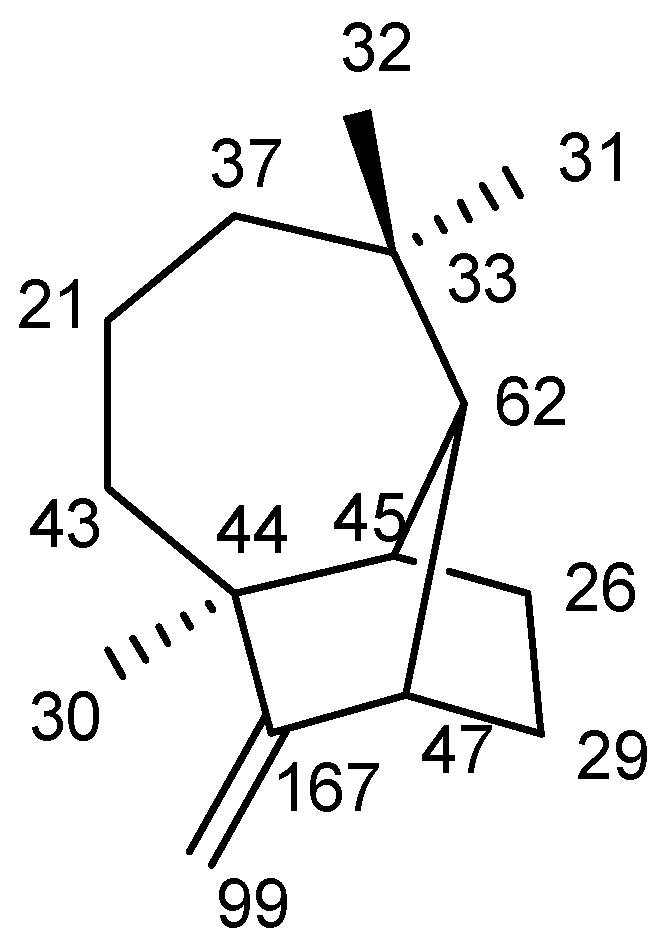
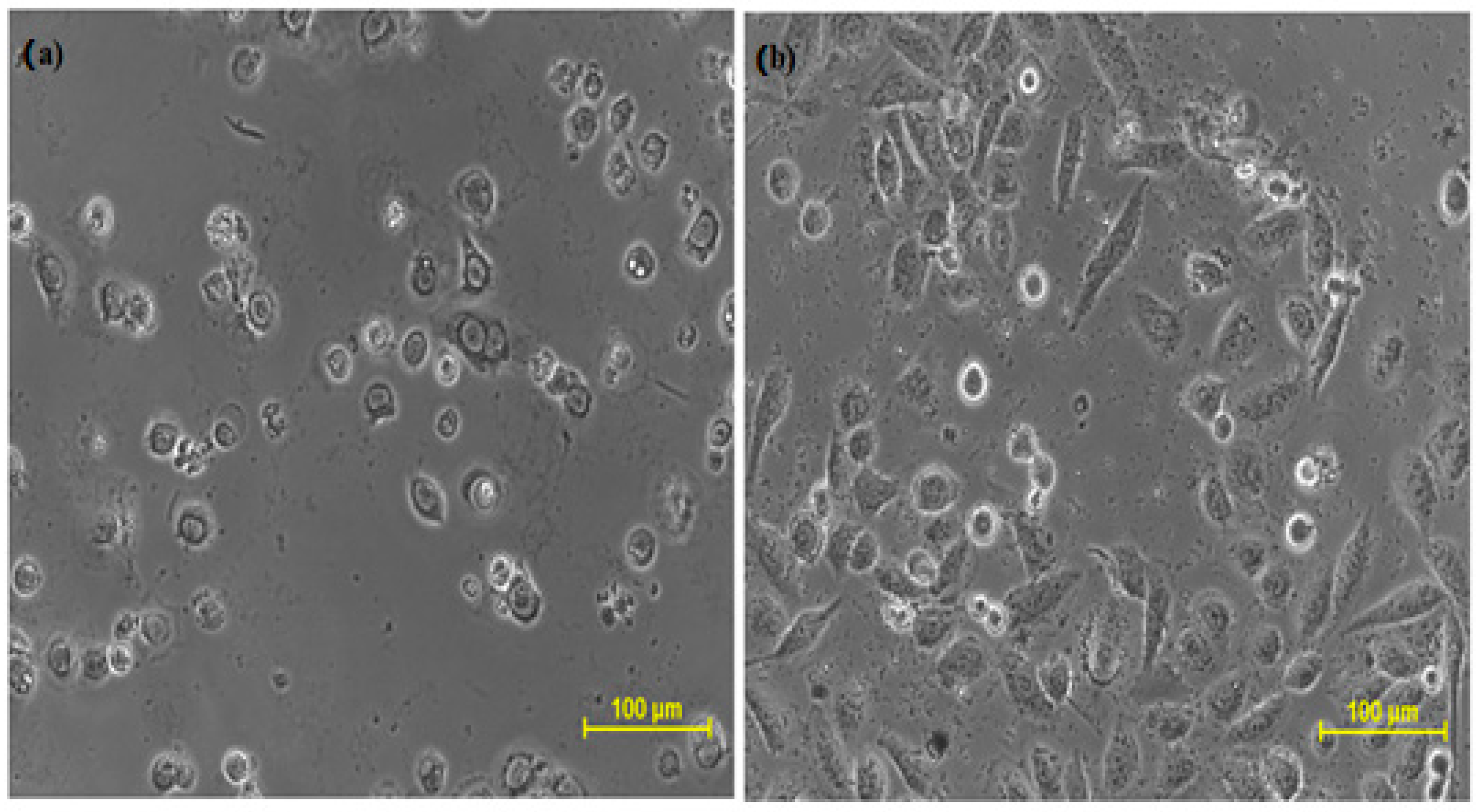
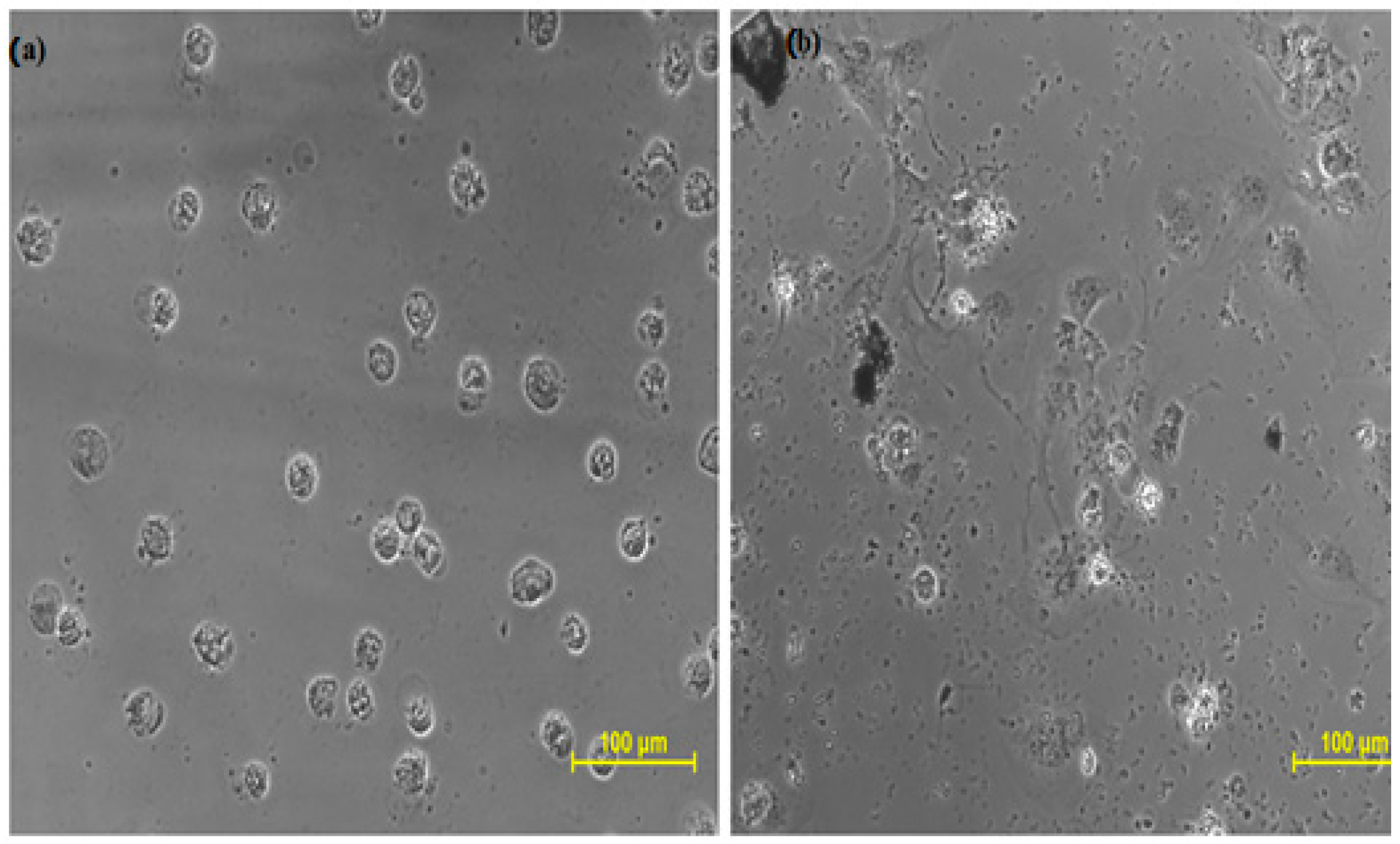

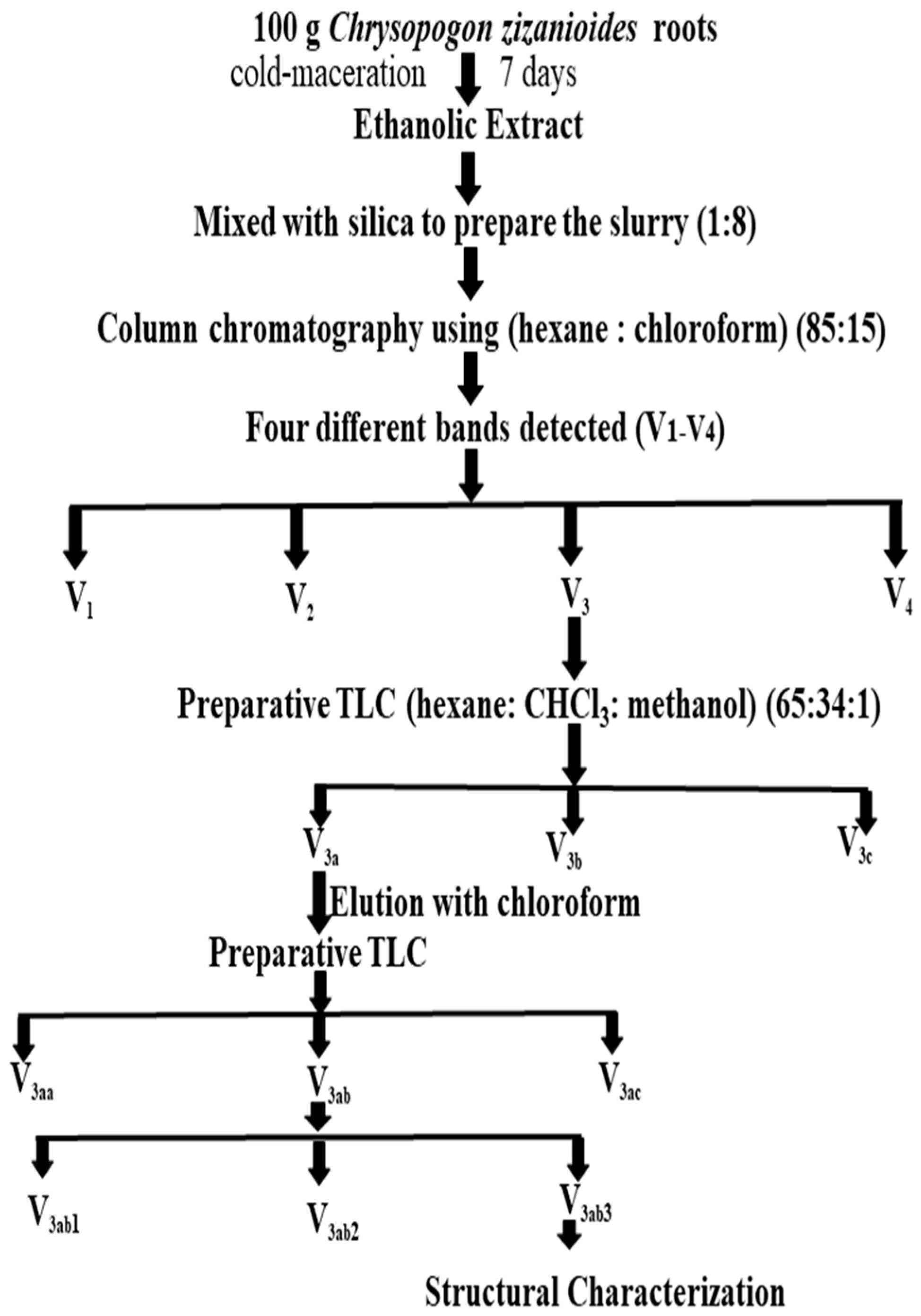
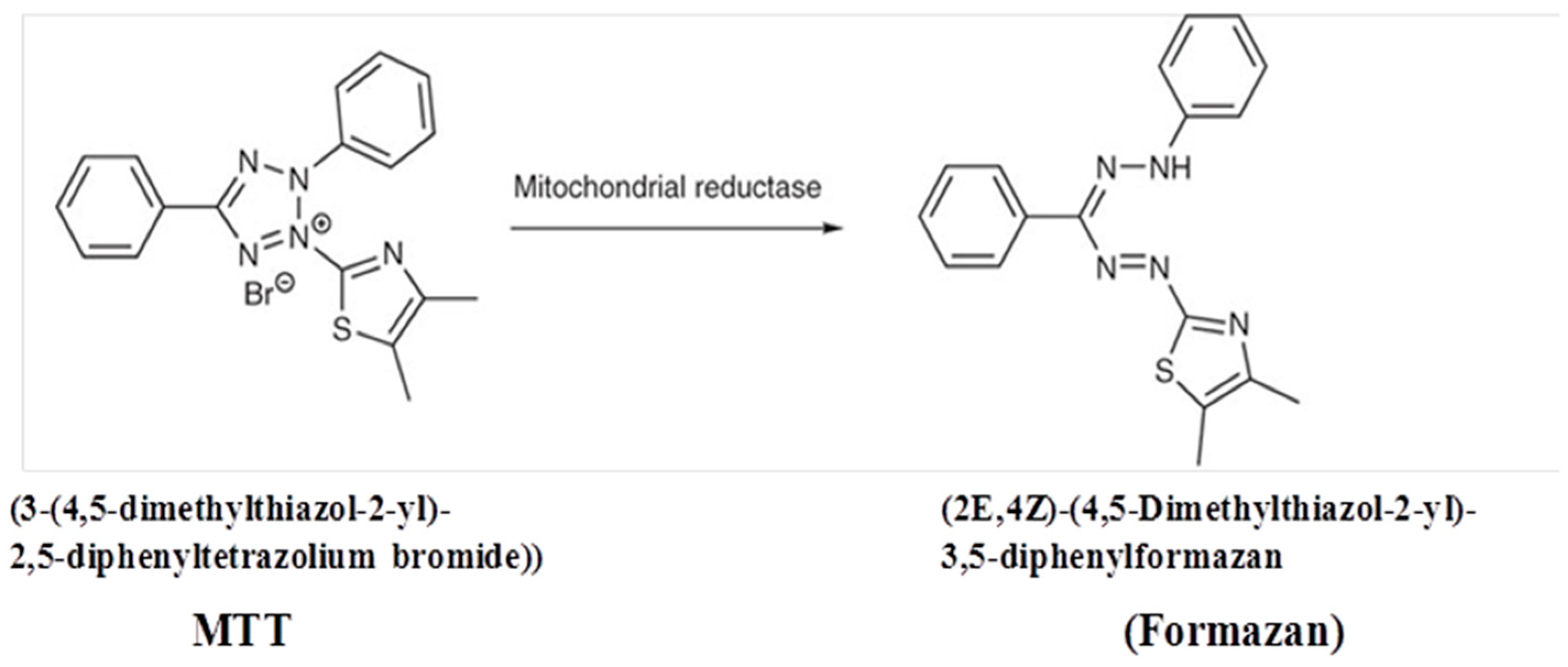
| DU-145 | ||||
|---|---|---|---|---|
| Test Sample | Concentration (µg/mL) | Optical Density at 590 nm | % Inhibition | IC50 (µg/mL) |
| Control | 0 | 0.656 | 0.00 | |
| Doxorubicin | 1.7 | 0.523 | 20.27 | 10.67 |
| 3.4 | 0.413 | 37.04 | ||
| 6.8 | 0.365 | 44.36 | ||
| 13.6 | 0.241 | 63.26 | ||
| 27.16 | 0.168 | 74.39 | ||
| 54.32 | 0.069 | 89.48 | ||
| Longifolene | 10 | 0.578 | 11.89 | 78.64 |
| 20 | 0.501 | 23.63 | ||
| 40 | 0.423 | 35.52 | ||
| 80 | 0.306 | 53.35 | ||
| 160 | 0.227 | 65.40 | ||
| 320 | 0.109 | 83.38 | ||
| SCC-29B | ||||
|---|---|---|---|---|
| Test Sample | Concentration (µg/mL) | Optical Density at 590 nm | % Inhibition | IC50 Value (µg/mL) |
| Control | 0 | 0.521 | 0.00 | 0 |
| Doxorubicin | 1.7 | 0.423 | 18.81 | 9.56 |
| 3.4 | 0.336 | 35.51 | ||
| 6.8 | 0.284 | 45.49 | ||
| 13.6 | 0.206 | 60.46 | ||
| 27.16 | 0.146 | 71.98 | ||
| 54.32 | 0.067 | 87.14 | ||
| Longifolene | 10 | 0.468 | 10.17 | 88.92 |
| 20 | 0.417 | 19.96 | ||
| 40 | 0.346 | 33.59 | ||
| 80 | 0.275 | 47.22 | ||
| 160 | 0.198 | 62.00 | ||
| 320 | 0.109 | 79.08 | ||
| Vero | ||||
|---|---|---|---|---|
| Test Sample | Concentration (µg/mL) | Optical Density at 590 nm | % Inhibition | IC50 Value (µg/mL) |
| Control | 0 | 0.498 | 0.00 | 0 |
| Doxorubicin | 1.7 | 0.467 | 6.22 | 29.12 |
| 3.4 | 0.429 | 13.86 | ||
| 6.8 | 0.389 | 21.89 | ||
| 13.6 | 0.352 | 29.32 | ||
| 27.16 | 0.260 | 47.79 | ||
| 54.32 | 0.189 | 62.05 | ||
| Longifolene | 10 | 0.486 | 2.41 | 246.3 |
| 20 | 0.456 | 8.43 | ||
| 40 | 0.410 | 17.67 | ||
| 80 | 0.369 | 25.90 | ||
| 160 | 0.320 | 35.74 | ||
| 320 | 0.213 | 57.23 | ||
| Cell Type | Cell Line | Cytotoxicity Profile (IC50 µg/mL) | |
|---|---|---|---|
| Longifolene (µg/mL) | Dox (µg/mL) | ||
| Prostate Cancer | DU-145 | 78.64 ± 0.5 | 10.67 ± 0.5 |
| Oral Cancer | SCC-29B | 88.92 ± 0.5 | 9.56 ± 0.5 |
| Healthy cell line | Vero cells | 246.3 ± 0.5 | 29.12 ± 0.5 |
Publisher’s Note: MDPI stays neutral with regard to jurisdictional claims in published maps and institutional affiliations. |
© 2022 by the authors. Licensee MDPI, Basel, Switzerland. This article is an open access article distributed under the terms and conditions of the Creative Commons Attribution (CC BY) license (https://creativecommons.org/licenses/by/4.0/).
Share and Cite
Grover, M.; Behl, T.; Virmani, T.; Sanduja, M.; Makeen, H.A.; Albratty, M.; Alhazmi, H.A.; Meraya, A.M.; Bungau, S.G. Exploration of Cytotoxic Potential of Longifolene/Junipene Isolated from Chrysopogon zizanioides. Molecules 2022, 27, 5764. https://doi.org/10.3390/molecules27185764
Grover M, Behl T, Virmani T, Sanduja M, Makeen HA, Albratty M, Alhazmi HA, Meraya AM, Bungau SG. Exploration of Cytotoxic Potential of Longifolene/Junipene Isolated from Chrysopogon zizanioides. Molecules. 2022; 27(18):5764. https://doi.org/10.3390/molecules27185764
Chicago/Turabian StyleGrover, Madhuri, Tapan Behl, Tarun Virmani, Mohit Sanduja, Hafiz A. Makeen, Mohammed Albratty, Hassan A. Alhazmi, Abdulkarim M. Meraya, and Simona Gabriela Bungau. 2022. "Exploration of Cytotoxic Potential of Longifolene/Junipene Isolated from Chrysopogon zizanioides" Molecules 27, no. 18: 5764. https://doi.org/10.3390/molecules27185764
APA StyleGrover, M., Behl, T., Virmani, T., Sanduja, M., Makeen, H. A., Albratty, M., Alhazmi, H. A., Meraya, A. M., & Bungau, S. G. (2022). Exploration of Cytotoxic Potential of Longifolene/Junipene Isolated from Chrysopogon zizanioides. Molecules, 27(18), 5764. https://doi.org/10.3390/molecules27185764








